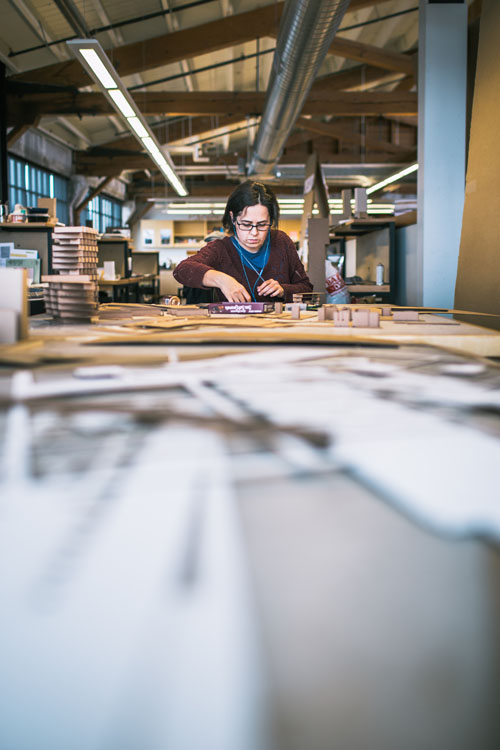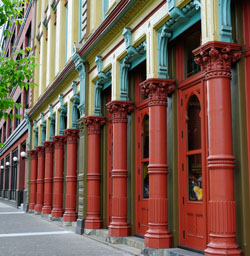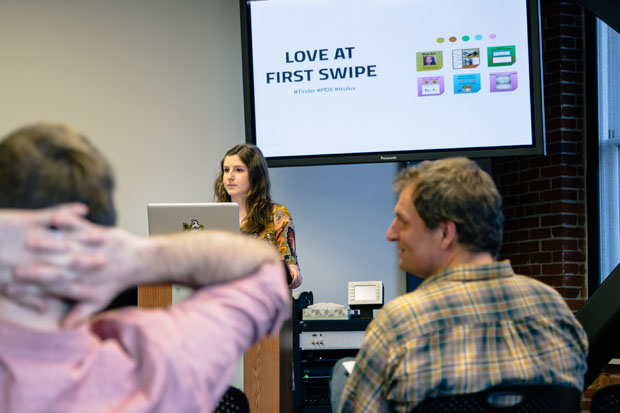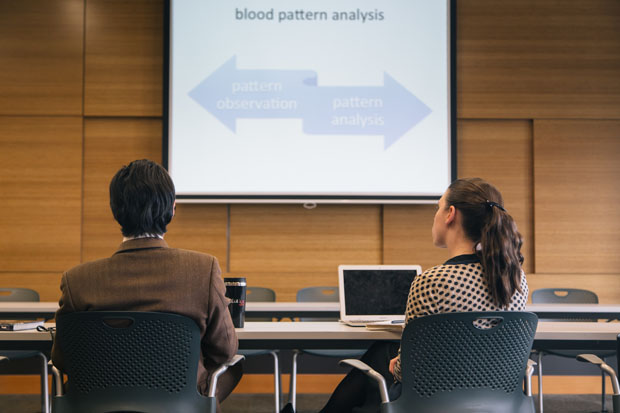BY ERIN J. BERNARD
Old Town Portland’s White Stag Block has long been an incubator for big ideas. Over the course of a century, its historic buildings have busily churned out everything from sportswear to sawmill machinery as the city beyond expanded and modernized.
BY ERIN J. BERNARD
UO Portland programs push innovation, engagement
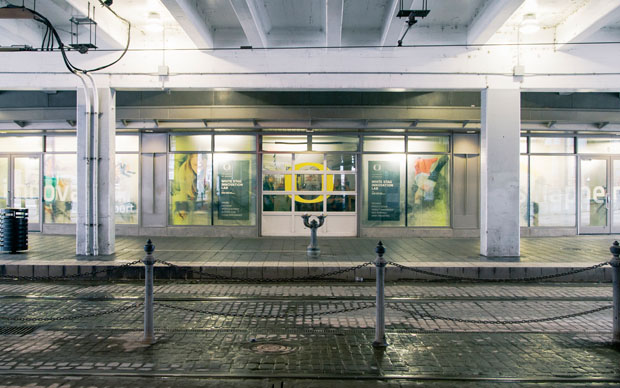
The White Stag Innovation Lab, located under the Burnside Bridge.
Old Town Portland’s White Stag Block has long been an incubator for big ideas. Over the course of a century, its historic buildings have busily churned out everything from sportswear to sawmill machinery as the city beyond expanded and modernized.
An architecture student building a |
The University of Oregon’s Portland programs took up residence here in 2008, and, true to its legacy, the block has since become a hub of innovative professional learning in the heart of a city that’s nowhere near finished evolving.
UO Portland offers a variety of post-baccalaureate learning opportunities, from master’s tracks to fifth-year programs, plus academic support programs and research centers. And its forward-thinking bent and central location enable it to build essential bridges that connect students with the world outside the halls of academia, according to Wendy Larson, vice provost for Portland programs.
“It’s important to be in a metropolitan area to do that,” she says. “UO Portland has developed its programs with a keen eye towards innovation in industry and the professions. The city offers great opportunities for students to get hands-on experience with experts in their fields.”
A thriving alumni association regularly brings together Portland’s sizeable alumni population for sporting, networking and service events. And UO Portland’s White Box gallery, open to the public, enables students and faculty to collaborate with change makers across the globe on contemporary art and design projects.
Now, UO Portland is expanding its offerings even further to include a burgeoning third-year Portland program for UO law students that leverages the city’s vast networking web; tandem Sports Product Design/Management Programs that mingle the business and design disciplines; and a suite of state-of-the-art experiential learning spaces that offer dynamic introductions to quickly changing fields.
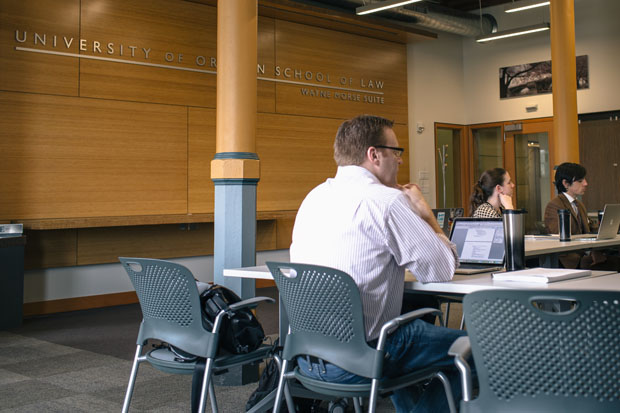
Law students sit in the Wayne Morse Suite, home of UO Portland’s law program.
Oregon Law Portland Program: Cultivating Connections
Whichever academic path a student takes, a little mentorship can go a long way. Alumni and professional connections are particularly important for law students, says Mohsen Manesh, assistant professor and faculty director for the Oregon Law Portland Program, and Portland’s got them in abundance.
Beginning this fall (pending American Bar Association approval), the Portland Program will invite 30 students annually to complete their third-year of law school in Portland.
The UO Law School began in Portland in 1884, and growing its presence at the doorstep of the city’s courts, law firms and businesses is only natural, says Manesh: “If we’re going to be true to our public mission and the reputation we have in serving the state, it’s critical for us to have a meaningful, engaged presence with the Portland legal community.”
Portland-based students can easily attend bar events and speaker panels to cultivate deeper relationships with internship and externship employers and participate in alumni mentorship opportunities — vital opportunities in such a relationship-dependent field, says Manesh: “It’s important to be able to participate, and the earlier you can start, the better.”
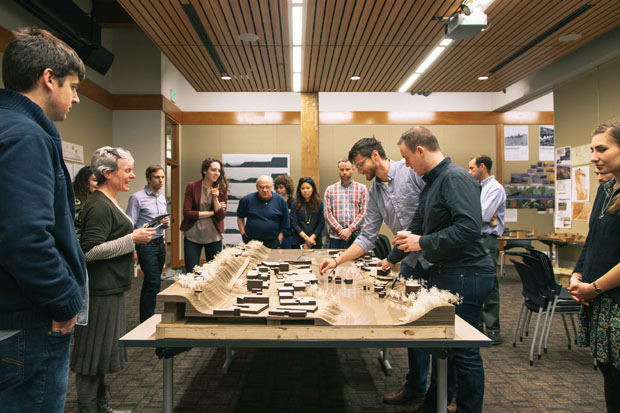
The Master’s of Architecture students discuss the process of redesigning the Oregon City waterfront, the focus of their final project.
Department of Architecture & Allied Arts: Sustaining Innovation
Teaching students to think sustainably and creatively across cultures, environments, and disciplines as they tackle complex tasks is also vital, says Kate Wagle, associate dean and director for Architecture & Allied Arts at UO in Portland.
The city has been the long-time home for a UO architecture graduate program. Now in the works for A&AA: the relocation of UO’s Historic Preservation program to Portland, plus the proposed debut of a new Sports Product Design program in 2016.
Any good education in art, design and architecture will emphasize experimentation, says Wagle, and A&AA is committed to fostering the space for that experimenting to happen. Sports Product Design students will tackle new materials and techniques on high-end manufacturing equipment in the White Stag Innovation Lab. They’ll also collaborate with other departments, city entities, and product designers in other countries as they learn and explore.
Wagle is confident that arming Sports Product students with cross-disciplinary knowledge will prime them for hire by the 800-plus Portland-based sports product businesses: “This is something the industry doesn’t have and really wants,” she says. “They want business students who understand the design process and they want employees in design who understand the business end of it.”
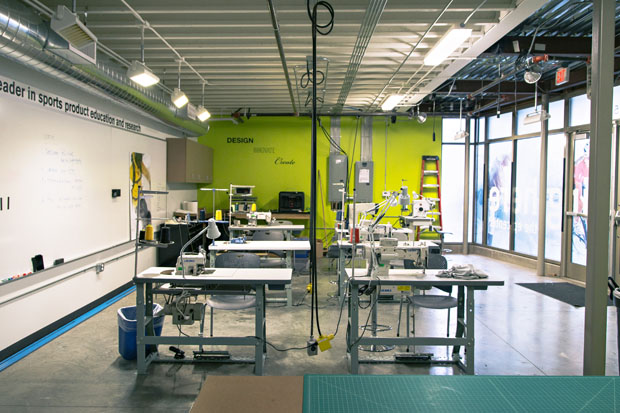
The lab includes spaces for collaboration, teaching and hands-on work.
Lundquist College of Business: Encouraging enterprise
Sometimes the best way to stay fresh is to keep things moving — literally. UO Portland’s Lundquist College of Business will soon relocate its growing Executive MBA program to a building across the way from the White Stag Block, a space it will share with a brand new Sports Product Management master’s program.
Historic cast iron columns make the
|
The OEMBA program attracts mid-career professionals ready to pair their expertise with a bit of innovative thinking, says OEMBA Executive Director David Boush. Case in point: recent grad Ellen Schmidt-Devlin, who worked in sports products for decades and now sits at the helm of UO’s Sports Product Initiative — the first of its kind in the US.
On the innovation and research front, UO Portland’s White Stag Innovation Lab and a connected Retail Lab will take students through the sports product life cycle firsthand. And the program will be populated by talented students primed to excel in this specialized industry, she adds: “This program is not about getting a job. You can get a job on your own already. This is about a career.”
The program will operate in tandem with A&AA’s Sports Product Design program, it will partner with universities around the country, and it will share classroom space with the OEMBA program. Its prize assets: the thriving industry before it and the thriving institution behind it.
“This program really capitalizes on the equity of Portland and the equity of U of O,” says Boush.
Journalism & Communication Masters students research and prepare pitching story ideas in under five minutes.
George S. Turnbull Portland Center: Engaging the Masses
Of course, graduates can’t succeed far into the uncertain future unless they’re also able to adapt. Nowhere is this truer than in the media fields, and UO Portland’s journalism and communications programs are meeting the challenge head-on.
It’s a strange new world, but students are eager to rethink and retool based on shifting needs, says Mike Fancher, Interim Executive Director of the Center for Journalism Innovation and Civic Engagement and George S. Turnbull Center: “Students are really comfortable with this kind of exploration…They understand that the world in which they live and in which they communicate in is so dynamic.”
The school maintains robust relationships with Portland-based media outlets, but it’s also engaging the surrounding community by bringing together media and community members for interactive events.
Students in the Criminal Justice program sit in for a lecture on the history & use of blood pattern analysis.
Ties that Bind
No matter the discipline, UO Portland offers endless opportunities for exposing students to organic, meaningful interactions, says Manesh: “We see this building and its location in the heart of downtown as a tremendous draw and a tremendous asset.”
And no matter how the city beyond the White Stag Block changes in coming decades, the synergy between UO Portland’s programs and the larger community will keep things interesting far into the future, predicts Fancher: “When you bring people together who don’t normally have the opportunity to meet and exchange ideas, all kinds of possibilities emerge.” n
Interested in finding out more about the University of Oregon’s Portland programs? An open house will be held 6-9 p.m. June 4 at the White Stag Block, 70 NW Couch St.


